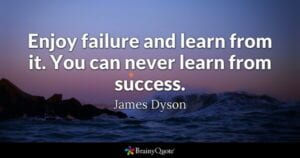I think James Dyson is an example of what a designer should be. Despite Dyson being a billionaire, he still hasn’t forgotten about meeting demands and works hard to make his products the best they can be. He makes his products with a purpose and intended audience. I think designers should make their products for the people, taking people’s wants and needs into consideration, if not what is the purpose of making a product. Isn’t innovation meant to help others?
Month: March 2022
On Philippe Starck And His Design Work
I think Philippe Strack is a very unique designer as he goes against what you are taught when making designs. When making prototypes you are taught to seek out your clients’ ideas and observe them so that based on your target audience you can perfect your product. On the other hand, Strack avoids any contact as he doesn’t want to be influenced when making designs, he doesn’t even know other designers’ work.
I think his methods are shocking. He lives in abstraction, his life is his projects. I think it’s a bit extreme that but it does show his passion for his work and his commitment to his creativity. He goes as far as not communicating or keeping up with what’s going around him, he lives like a monk. I don’t think many can manage to be as committed to their work to cut off contact with the whole work, as most people work to enjoy their own life. I wonder how does he know how and what to design if he doesn’t keep in contact with the outside world.
I find it interesting how he doesn’t think he is that big of a deal in the world of design as he is such a big name and he can come up with designs immediately, not everyone can do that. The professional process is the last step for him when designing, unlike conventional designers, which makes him a special designer and brings him so much attention. I think a reason for this is because he does not think he is intelligent and he believes to be a good designer you have to be intelligent. He goes through these extreme methods, such as living a monk-like life, in order to make up for his “lack of intelligence” as he believes it’s the only way he can get the results.
As a final remark, I am surprised that he is so committed to his work yet he states multiple times that design can help life but not save a life in a negative tone. Like what motivates him to still work and believe in this field if it doesn’t save a life, as he believes that is what matters.
Industrial Design Response – Week 5
Before watching these videos I thought that when making an industrial design it didn’t need much thought and was more about aesthetics. I also believed that products would be made for the average person to reach a bigger market since they would be usable by most. After watching these videos I learned that industrial design isn’t about aesthetics but comfort and usability. I also learned that there was no such thing as targeting the average person during the industrial design process. Products should be made to combat a problem other designs or versions of that product could create then adapt it to make it easy to use for everyone, bringing in a bigger market versus just targeting the average person. Due to this is important to have the industrial design process because our products would be inconvenient and possibly even impossible to use for some users. The industrial design makes everyone’s life easier even in small tasks such as washing dishes as all physical products we use went through some industrial design.
One product I enjoy using on a daily basis would be a porcelain crock(water dispenser). I enjoy using this because it allows me to instantly fill my water bottles or cups. I also don’t have to filter the water since the water in the gallon is already filtered so I can instantly drink it without thinking about it. I think it is more convenient than more modern water dispensers since you can always see when the water is about to run out which can avoid dehydrating situations.

Another product that I enjoy using is my bottle opener. I enjoy using it because it gives a safe, quick, and convenient way to open my favorite glass bottle drinks. When I first when to university I didn’t have a bottle opener to open my favorite drink so after attempts of people trying to open it, my drink just sat in the refrigerator for months until I saw someone with a bottle opener. It can be very dangerous to attempt to open a glass bottle without a bottle opener as it can break and cut you. I am glad that I have a bottle opener once again.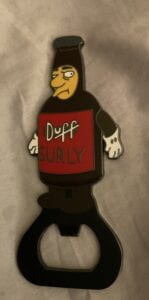
Week 3: Not My Problem
User Interview:
My application is for Melissa Palacios a university student. The problem she wants to solve is to stop missing school deadlines which is caused by her playing games and being on social media instead of working on schoolwork. I think that Melissa suffers from a lack of time management and see an opportunity to create an application in order to monitor and improve her time management so that she can get her schoolwork done in time. My user’s problem can be solved with a time management app that gives her a daily schedule and limits her time on leisure applications. The measurable outcome she wants to achieve is being able to complete all her homework of the day and then be able to play games or go on social media.
Design:
Application Icon:
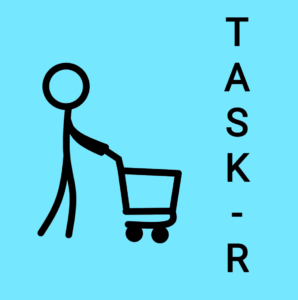
Application Screens:
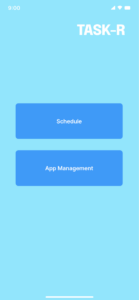
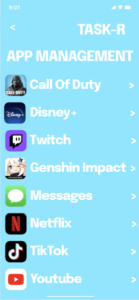
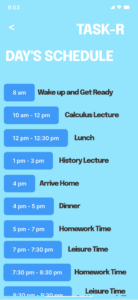
Description:
TASK-R is an app to help with time management and avoid unnecessary time on leisure apps that can lead to disruptions in your schedule. The app does this by giving you the feature to limit the time you can use an app every day, alongside a daily schedule in order to keep up with your daily tasks.
Prototype Link: https://framer.com/projects/TASK-R-Prototype–pMkkF7nYvgsJiegsPqd9-1Sox1
Presentation:
I presented my application to Melissa, the university student whose problem gave me the app idea. By presenting my application I hoped to get a better insight into what screens needed improvement design-wise and if my app was easy to use. While Melissa used the app in the test I noticed that the design of the app catered to her taste and it didn’t seem tedious for her to use. When getting feedback she said she liked the ability to scroll in the app management section and the schedule design. She also said it was hard to navigate through the days when having to choose one in the weekly schedule. As a result of this presentation, I will change the day selection from a drop-down list to buttons.
Talking to Humans Book Reflection
1) Prior to reading the book, how important would you consider talking to people to be when designing an application? Did that change at all after reading the book? Why?
Prior to reading the book, I didn’t think it was important to talk to people when designing an application. I thought this because I believed that the creator had to develop the app to their preference, focusing it more on what they think instead of others. After reading the book my perspective has changed because it showed me that in order to have a marketable application you need to start with your vision as a base point then incorporate the target audience’s vision and combine them. Talking to people when designing an application is also important because you will get to know what a suitable design style and app purpose would be for the target audience.
2) How has your understanding of a “Prototype” changed after reading this book (if at all)?
My understanding of a “Prototype” has changed. Before reading this book I believed when making a prototype it had to be general and cater to everyone. I also believed when making an app it had to be based on individual thinking without others’ input. I realized after reading the book that when making a prototype the app needs to target a specific group at first and then expand the target audience. This is because not everyone is willing to try new products and you need to find the demographic most willing to try them out which is referenced as early adopters in the book.
3) What specific techniques did you use from this book to help you in your client interviews for Challenge 1, Part 3?
Get Stories, Not Speculation
Ask Open-Ended Questions
The Magic Wand Question
Disarm My Own Biases
Understanding Priority
